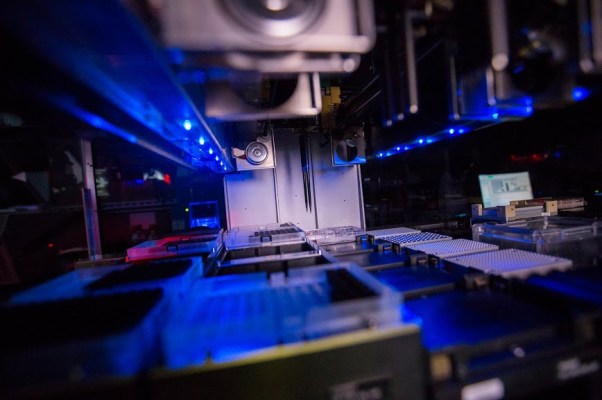A science lab in Mountain View, Calif., is creating faster and cheaper drug experiments by putting them in the cloud. Starting today, they’re letting other scientists access their cloud lab to help spur a radical change in the way we test new drugs. The key, says co-founder of Emerald Cloud Laboratory, D.J. Kleinbaum, is automated robots.
ECL grew out of Silicon Valley biotech startup Emerald Therapeutics. Founders Kleinbaum and Brian Frezza, both lifelong friends who grew up houses apart on Emerald Drive in Philly, got the idea for the cloud lab out of something called Eroom’s Law. For all you computer nerds, yes, that is Moore’s Law spelled backwards.
Eroom’s Law works on the idea that the number of new drugs approved by the US Food and Drug Administration (FDA) per billion US dollars spent on research and development will split in half about every nine years. Translation: researchers need money to fund their drug experiment habit. The problem with this is money isn’t always easy to come by for unproven, experimental drugs.
Kleinbaum and Frezza took a look at the current state of drug labs — long lag in results, high cost, lots of middle men — and realized the model most researchers are working with would quite possibly collapse within 30 years.
“We looked at what other industries had done and asked what is different from DNA sequencing and biosynthesis that is different from other bio?” That’s when they turned to semiconductors and the idea for using robots. “[Semiconductors] have an extreme focus on automation in code that is fully reproducible by a machine,” says Frezza. Soon the two realized they could take the same idea and apply it to their lab at Emerald Therapeutics. But first they’d need to get into the computer programming business. With $2.5 million worth of equipment and 5,000 square feet of space, the whole operation now runs on Wolfram Language.
What this means is that what would normally cost millions of dollars to produce and take months to run can be produced in the cloud lab for a couple bucks and delivered within a day or two.
“We believe there is a role for what we call ‘Lean Biotech,’” says Frezza, “Biotech is not lean, in fact it’s going in the opposite direction, so we think in order to improve healthcare, treat diseases, or positively affect everyday life in myriad ways, we have to reimagine biotech as an industry.”
Lab experiments are now entirely robotic from end to end. The scientists don’t even touch them. That kind of push-button reproducibility also makes it easy for researchers to get more concise results. According to Frezza, big pharma like Bayer can’t even get very good consistency. One such trial for the lung drug Actelion only had a 63 percent chance of success in the lab. That number is consistent with other findings. Of 53 papers published at Amgen, results could only be confirmed in six (11 percent) of the cases. ECL believes adding that extra robot layer means consistency of outcome is much more likely.
This model has worked well enough for Emerald Therapeutics that ECL is now opening up its cloud lab to other research firms. It’s a slow rollout of an “outward-facing beta trial” for now. Researchers will be able to ship their samples to ECL and then place an order in the cloud for just $1-$25, depending on the experiment. Results can come back to the researcher as soon as that same afternoon.
Founders Fund, PayPal co-founder Max Levchin and Schooner Capital supported the lab in the latest round of financing for a total of $13.5 million.
ECL will also put up an ontology-indexed database that will be accessible in the cloud. Researchers will be able to look up similar experiments to theirs, as well as add their experiment to the cloud database for other researchers. The first year of access to the cloud database is free. Kleinbaum says it will be a nominal fee per gigabyte after that, but if you are willing to publish your own data, then you can continue to access the database free of charge.
The goal, says Kleinbaum, “is to be the Amazon Web Services of wet lab experiments.” Much like cloud services lowered the cost barrier for startups and small companies, automating the lab with robots and putting information in the cloud lowers costs, furthers research and cuts the time it takes to get confirmation on results. “It’s a huge difference in doing one experiment that takes a couple of months to running multiple experiments a day.”
Opening up the lab to outside researchers and reproducing consistent results, faster and cheaper could mean the difference between life or death for some. Emerald Therapeutics, for instance, is working on life-saving vaccines for HIV and HPV. Results aren’t available for that just yet (or at least not results they’re willing to discuss), but the process is certainly clipping along faster than it would in the past.
Outside researchers will be able to order up to 40 of the major in vitro molecular and cellular biology experiments using the robotic equipment at ECL. The plan is to expand to hundreds of other experiments in the next 18 months.
“We consider ourselves proud members of a larger scientific community and want to open this system up to everyone so that we can all benefit from an accelerated pace of research,” says Kleinbaum.
